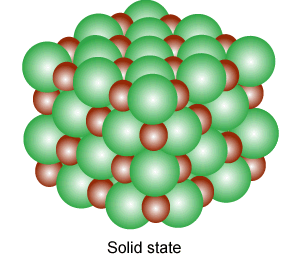Which of the following is NOT true about the amorphous solids ?
Which of the following is NOT true about the amorphous solids ?
- Amorphous solids can be moulded by heating.
- On heating they may become crystalline on certain temperature.
- They are anisotropic in nature
- They may become crystalline on keeping for long time.
The Correct Option is C
Approach Solution - 1
The statement that is NOT true about amorphous solids is: (C) They are anisotropic in nature.
Amorphous solids do not have a well-defined long-range order like crystalline solids. They have a disordered arrangement of atoms or molecules, resulting in a lack of symmetry in their structure. Due to this lack of long-range order, amorphous solids exhibit isotropic properties, meaning their properties are the same in all directions. In contrast, crystalline solids have a well-defined periodic arrangement and can exhibit anisotropic properties, meaning their properties can vary depending on the direction.
Therefore, amorphous solids are NOT anisotropic in nature.
Approach Solution -2
Which of the following is NOT true about the amorphous solids
- Amorphous solids can be moulded by heating – ✅ True
- On heating they may become crystalline at certain temperature – ✅ True
- They are anisotropic in nature – ❌ False
- They may become crystalline on keeping for long time – ✅ True
Explanation:
Amorphous solids are isotropic in nature, meaning their physical properties are the same in all directions because they lack a regular and long-range arrangement of particles. Hence, the statement "They are anisotropic in nature" is not true.
Correct Answer: They are anisotropic in nature
Top Questions on The solid state
- A metal crystallizes in simple cubic lattice. The volume of one unit cell is \( 6.4 \times 10^{-7} \, \text{pm}^3 \). What is the radius of the metal atom in pm?
- AP EAPCET - 2025
- Chemistry
- The solid state
- A metal crystallises in two cubic phases, fcc and bcc with edge lengths 3.5 Å and 3 Å respectively. The ratio of densities of fcc and bcc is approximately
- TS EAMCET - 2025
- Chemistry
- The solid state
- How many kinds of Bravais lattice are possible in a crystal?
- Bihar Board XII - 2025
- Chemistry
- The solid state
- The percentage of free space in a body-centred cubic unit cell is
- Bihar Board XII - 2025
- Chemistry
- The solid state
- The number of atoms present in body-centred cubic unit cell is
- Bihar Board XII - 2025
- Chemistry
- The solid state
Questions Asked in KCET exam
A block of certain mass is placed on a rough floor. The coefficients of static and kinetic friction between the block and the floor are 0.4 and 0.25 respectively. A constant horizontal force \( F = 20 \, \text{N} \) acts on it so that the velocity of the block varies with time according to the following graph. The mass of the block is nearly (Take \( g = 10 \, \text{m/s}^2 \)):

- KCET - 2025
- work, energy and power
- Given, a current carrying wire of non-uniform cross-section, which of the following is constant throughout the length of the wire?
- KCET - 2025
- Current electricity
- If the number of terms in the binomial expansion of \((2x + 3)^n\) is 22, then the value of \(n\) is:
- KCET - 2025
- Binomial theorem
- Ethyl alcohol is heated with concentrated sulphuric acid at 413 K (140°C). The major product formed is
- KCET - 2025
- Organic Chemistry
- A body of mass 0.25 kg travels along a straight line from \( x = 0 \) to \( x = 2 \, \text{m} \) with a speed \( v = k x^2 \) where \( k = 2 \, \text{m}^{-1} \). The work done by the net force during this displacement is
- KCET - 2025
- Elastic and inelastic collisions
Concepts Used:
Solid State
Solids are substances that are featured by a definite shape, volume, and high density. In the solid-state, the composed particles are arranged in several manners. Solid-state, in simple terms, means "no moving parts." Thus solid-state electronic devices are the ones inclusive of solid components that don’t change their position. Solid is a state of matter where the composed particles are arranged close to each other. The composed particles can be either atoms, molecules, or ions.

Types of Solids:
Based on the nature of the order that is present in the arrangement of their constituent particles solids can be divided into two types;
- Amorphous solids behave the same as super cool liquids due to the arrangement of constituent particles in short-range order. They are isotropic and have a broad melting point (range is about greater than 5°C).
- Crystalline solids have a fixed shape and the constituent particles are arranged in a long-range order.